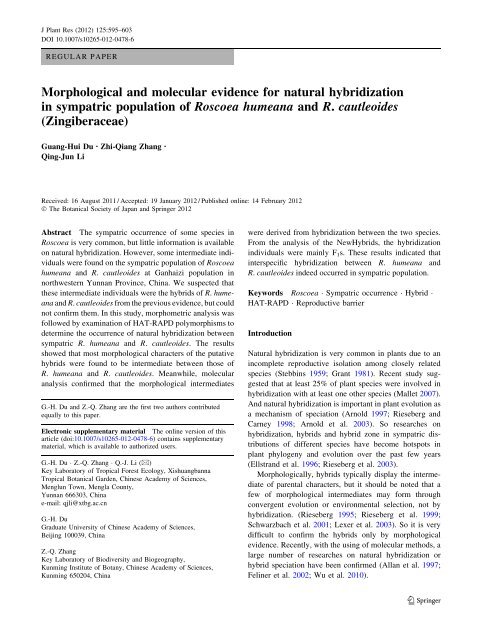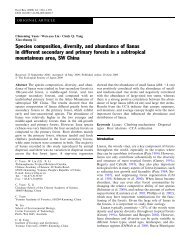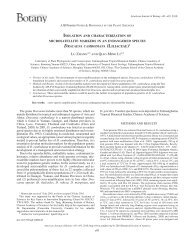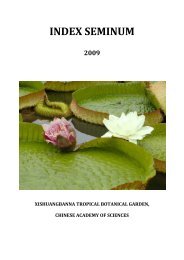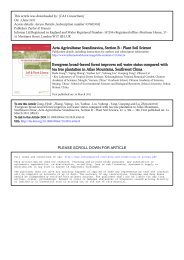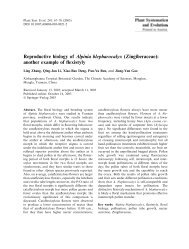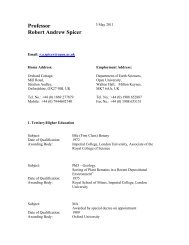Morphological and molecular evidence for natural hybridization in ...
Morphological and molecular evidence for natural hybridization in ...
Morphological and molecular evidence for natural hybridization in ...
You also want an ePaper? Increase the reach of your titles
YUMPU automatically turns print PDFs into web optimized ePapers that Google loves.
J Plant Res (2012) 125:595–603<br />
DOI 10.1007/s10265-012-0478-6<br />
REGULAR PAPER<br />
<strong>Morphological</strong> <strong>and</strong> <strong>molecular</strong> <strong>evidence</strong> <strong>for</strong> <strong>natural</strong> <strong>hybridization</strong><br />
<strong>in</strong> sympatric population of Roscoea humeana <strong>and</strong> R. cautleoides<br />
(Z<strong>in</strong>giberaceae)<br />
Guang-Hui Du • Zhi-Qiang Zhang •<br />
Q<strong>in</strong>g-Jun Li<br />
Received: 16 August 2011 / Accepted: 19 January 2012 / Published onl<strong>in</strong>e: 14 February 2012<br />
Ó The Botanical Society of Japan <strong>and</strong> Spr<strong>in</strong>ger 2012<br />
Abstract The sympatric occurrence of some species <strong>in</strong><br />
Roscoea is very common, but little <strong>in</strong><strong>for</strong>mation is available<br />
on <strong>natural</strong> <strong>hybridization</strong>. However, some <strong>in</strong>termediate <strong>in</strong>dividuals<br />
were found on the sympatric population of Roscoea<br />
humeana <strong>and</strong> R. cautleoides at Ganhaizi population <strong>in</strong><br />
northwestern Yunnan Prov<strong>in</strong>ce, Ch<strong>in</strong>a. We suspected that<br />
these <strong>in</strong>termediate <strong>in</strong>dividuals were the hybrids of R. humeana<br />
<strong>and</strong> R. cautleoides from the previous <strong>evidence</strong>, but could<br />
not confirm them. In this study, morphometric analysis was<br />
followed by exam<strong>in</strong>ation of HAT-RAPD polymorphisms to<br />
determ<strong>in</strong>e the occurrence of <strong>natural</strong> <strong>hybridization</strong> between<br />
sympatric R. humeana <strong>and</strong> R. cautleoides. The results<br />
showed that most morphological characters of the putative<br />
hybrids were found to be <strong>in</strong>termediate between those of<br />
R. humeana <strong>and</strong> R. cautleoides. Meanwhile, <strong>molecular</strong><br />
analysis confirmed that the morphological <strong>in</strong>termediates<br />
G.-H. Du <strong>and</strong> Z.-Q. Zhang are the first two authors contributed<br />
equally to this paper.<br />
Electronic supplementary material The onl<strong>in</strong>e version of this<br />
article (doi:10.1007/s10265-012-0478-6) conta<strong>in</strong>s supplementary<br />
material, which is available to authorized users.<br />
G.-H. Du Z.-Q. Zhang Q.-J. Li (&)<br />
Key Laboratory of Tropical Forest Ecology, Xishuangbanna<br />
Tropical Botanical Garden, Ch<strong>in</strong>ese Academy of Sciences,<br />
Menglun Town, Mengla County,<br />
Yunnan 666303, Ch<strong>in</strong>a<br />
e-mail: qjli@xtbg.ac.cn<br />
G.-H. Du<br />
Graduate University of Ch<strong>in</strong>ese Academy of Sciences,<br />
Beij<strong>in</strong>g 100039, Ch<strong>in</strong>a<br />
Z.-Q. Zhang<br />
Key Laboratory of Biodiversity <strong>and</strong> Biogeography,<br />
Kunm<strong>in</strong>g Institute of Botany, Ch<strong>in</strong>ese Academy of Sciences,<br />
Kunm<strong>in</strong>g 650204, Ch<strong>in</strong>a<br />
were derived from <strong>hybridization</strong> between the two species.<br />
From the analysis of the NewHybrids, the <strong>hybridization</strong><br />
<strong>in</strong>dividuals were ma<strong>in</strong>ly F 1 s. These results <strong>in</strong>dicated that<br />
<strong>in</strong>terspecific <strong>hybridization</strong> between R. humeana <strong>and</strong><br />
R. cautleoides <strong>in</strong>deed occurred <strong>in</strong> sympatric population.<br />
Keywords Roscoea Sympatric occurrence Hybrid <br />
HAT-RAPD Reproductive barrier<br />
Introduction<br />
Natural <strong>hybridization</strong> is very common <strong>in</strong> plants due to an<br />
<strong>in</strong>complete reproductive isolation among closely related<br />
species (Stebb<strong>in</strong>s 1959; Grant 1981). Recent study suggested<br />
that at least 25% of plant species were <strong>in</strong>volved <strong>in</strong><br />
<strong>hybridization</strong> with at least one other species (Mallet 2007).<br />
And <strong>natural</strong> <strong>hybridization</strong> is important <strong>in</strong> plant evolution as<br />
a mechanism of speciation (Arnold 1997; Rieseberg <strong>and</strong><br />
Carney 1998; Arnold et al. 2003). So researches on<br />
<strong>hybridization</strong>, hybrids <strong>and</strong> hybrid zone <strong>in</strong> sympatric distributions<br />
of different species have become hotspots <strong>in</strong><br />
plant phylogeny <strong>and</strong> evolution over the past few years<br />
(Ellstr<strong>and</strong> et al. 1996; Rieseberg et al. 2003).<br />
<strong>Morphological</strong>ly, hybrids typically display the <strong>in</strong>termediate<br />
of parental characters, but it should be noted that a<br />
few of morphological <strong>in</strong>termediates may <strong>for</strong>m through<br />
convergent evolution or environmental selection, not by<br />
<strong>hybridization</strong>. (Rieseberg 1995; Rieseberg et al. 1999;<br />
Schwarzbach et al. 2001; Lexer et al. 2003). So it is very<br />
difficult to confirm the hybrids only by morphological<br />
<strong>evidence</strong>. Recently, with the us<strong>in</strong>g of <strong>molecular</strong> methods, a<br />
large number of researches on <strong>natural</strong> <strong>hybridization</strong> or<br />
hybrid speciation have been confirmed (Allan et al. 1997;<br />
Fel<strong>in</strong>er et al. 2002; Wu et al. 2010).<br />
123
596 J Plant Res (2012) 125:595–603<br />
Molecular markers detect<strong>in</strong>g variation at the DNA level<br />
offer numerous advantages over morphological <strong>and</strong> biochemical<br />
techniques as they are stable <strong>and</strong> detectable <strong>in</strong> all<br />
tissues <strong>and</strong> not affected by environmental or developmental<br />
stage (T<strong>in</strong>gey <strong>and</strong> Del Tufo 1993). R<strong>and</strong>omly amplified<br />
polymorphic DNA (RAPD) us<strong>in</strong>g s<strong>in</strong>gle short arbitrary<br />
primers can quickly scan an entire genome without prior<br />
knowledge of the sequence (Williams et al. 1990). However,<br />
the major drawback of the method is that the profil<strong>in</strong>g<br />
is sensitive to changes <strong>in</strong> the reaction conditions <strong>and</strong> the<br />
b<strong>and</strong> reproducibility is very low, ma<strong>in</strong>ly attributed to the<br />
low anneal<strong>in</strong>g temperatures (Agarwal et al. 2008).<br />
Anuntalabhochai et al. (2000) reported a high anneal<strong>in</strong>g<br />
temperature RAPD (HAT-RAPD) technique, which had<br />
been shown greater polymorphism, reproducibility, <strong>and</strong><br />
high resolution by <strong>in</strong>creas<strong>in</strong>g the anneal<strong>in</strong>g temperature to<br />
over 46°C. This technique has already been successfully<br />
used <strong>in</strong> the tropical fruits (Cutler et al. 2006, 2007;<br />
Ruangsuttapha et al. 2007) <strong>and</strong> the cut flower curcuma<br />
(Anuntalabhochai et al. 2007).<br />
Roscoea J. E. Smith, the truly alp<strong>in</strong>e genus of Z<strong>in</strong>giberaceae,<br />
only comprises 18 species (Cowley 2007). Most<br />
species of Roscoea occur <strong>in</strong> the eastern Himalayas (Nepal to<br />
north India) <strong>and</strong> the Hengduan Mounta<strong>in</strong>s of southwest<br />
Ch<strong>in</strong>a, between 1,200 <strong>and</strong> 4,880 m (Cowley 2007). These<br />
areas were widely regarded as global biodiversity hotspots<br />
(Wilson 1992; Myers et al. 2000). And many cases about<br />
<strong>natural</strong> <strong>hybridization</strong> had been reported <strong>in</strong> these areas (Zha<br />
et al. 2008, 2010; Zhu et al. 2009). Although the sympatric<br />
phenomenon <strong>in</strong> the genus of Roscoea is very common, little<br />
<strong>in</strong><strong>for</strong>mation is available on <strong>natural</strong> <strong>hybridization</strong>. It may be a<br />
reason why the orig<strong>in</strong> <strong>and</strong> relationship of some Roscoea<br />
species are not clear now.<br />
R. humeana Balf. f. & W. W. Sm <strong>and</strong> R. cautleoides<br />
Gagnep. are closely related based on the ITS region<br />
(Ngamriabsakul et al. 2000). However, their floral characters<br />
<strong>and</strong> vegetative features are quite different. R. humeana has<br />
ovate leaves, short or no peduncles <strong>and</strong> purple flowers with a<br />
longer floral tube. While R. cautleoides has narrowly lanceolate<br />
leaves, long peduncles <strong>and</strong> bright yellow flowers<br />
(Fig. 1). From the previous work (Zhang et al. 2011), we<br />
knew that R. humeana <strong>and</strong> R. cautleoides were sympatric on<br />
the Mt. Yulong (Lijiang city, Yunnan Prov<strong>in</strong>ce, Ch<strong>in</strong>a).<br />
Moreover, the flower<strong>in</strong>g seasons were completely overlapped<br />
<strong>and</strong> always lasted from early May to late June. The<br />
occasional poll<strong>in</strong>ator (Bombus sp.) was the common poll<strong>in</strong>ator<br />
of the two species. In addition, reciprocal h<strong>and</strong> poll<strong>in</strong>ations<br />
could produce fruit (unpublished data). All of the<br />
above made the possibility of <strong>natural</strong> <strong>hybridization</strong> occur. In<br />
fact, at the overlapped zone of the sympatric population of<br />
R. humeana <strong>and</strong> R. cautleoides, there were a few <strong>in</strong>dividuals<br />
which had short peduncle <strong>and</strong> long tubed flower as<br />
R. humeana, but had lanceolate leaves <strong>and</strong> yellow flower like<br />
R. cautleoides (Fig. 1). We suspected that these <strong>in</strong>dividuals<br />
were the hybrids of R. humeana <strong>and</strong> R. cautleoides. If so, it<br />
would help us to study the gene flow <strong>and</strong> gene <strong>in</strong>trogression<br />
between R. humeana <strong>and</strong> R. cautleoides, so morphological<br />
<strong>and</strong> <strong>molecular</strong> exam<strong>in</strong>ations were urgently required.<br />
In this study, morphological characters <strong>and</strong> HAT-RAPD<br />
genetic markers were used to <strong>in</strong>vestigate the putative<br />
Fig. 1 Floral <strong>and</strong> foliar morphology of R. humeana, putative hybrid <strong>and</strong> R. cautleoides, respectively. a The peduncle <strong>and</strong> bract of R. humeana,<br />
putative hybrid <strong>and</strong> R. cautleoides from left to right. b The leaf of R. humeana, putative hybrid <strong>and</strong> R. cautleoides from top to down. Bar 10 mm<br />
123
J Plant Res (2012) 125:595–603 597<br />
hybrids as a cross between R. humeana <strong>and</strong> R. cautleoides.<br />
Once the hybrid status was confirmed, <strong>and</strong> then each<br />
sample was divided <strong>in</strong>to different genotype classes to<br />
exam<strong>in</strong>e the population structure <strong>and</strong> the stability of<br />
hybrids.<br />
Materials <strong>and</strong> methods<br />
Study site <strong>and</strong> species<br />
The distributions R. humeana <strong>and</strong> R. cautleoides are similar<br />
ma<strong>in</strong>ly on the Hengduan Mounta<strong>in</strong>s of southwest Ch<strong>in</strong>a.<br />
Lijiang is located <strong>in</strong> the core area of the Hengduan Mounta<strong>in</strong>s<br />
<strong>and</strong> is considered to own the highest diversity of Roscoea<br />
species (Ngamriabsakul et al. 2000; Cowley 2007; Zhang<br />
<strong>and</strong> Li 2008; Zhang et al. 2011). In this study, the research<br />
site was located at Ganhaizi (GHZ), the core of the distributional<br />
ranges of R. humeana <strong>and</strong> R. cautleoides, 25km<br />
north of Lijiang city, <strong>in</strong> Yunnan, Ch<strong>in</strong>a, 27°05 0 N, 100°16 0 E,<br />
3,120 m above sea level where R. humeana <strong>and</strong> R. cautleoides<br />
occurred together. At GHZ, a grassy <strong>and</strong> rocky slope on<br />
Mt. Yulong, R. humeana is concentrated <strong>in</strong> the flat grassl<strong>and</strong>,<br />
while R. cautleoides is dom<strong>in</strong>ant on the rocky slop. The<br />
putative hybrids can only be found at the overlapped area<br />
mixed with R. humeana <strong>and</strong> R. cautleoides.<br />
Plant sampl<strong>in</strong>g<br />
<strong>Morphological</strong> characters such as flower color, leaf morphology,<br />
length of peduncle were used to dist<strong>in</strong>guish<br />
R. humeana, R. cautleoides <strong>and</strong> their putative hybrids <strong>in</strong><br />
the field. Because of their dist<strong>in</strong>ct floral <strong>and</strong> vegetative<br />
differences, it was very easy to discrim<strong>in</strong>ate two putative<br />
parental species <strong>in</strong> field. We chose r<strong>and</strong>omly 30 <strong>in</strong>dividuals<br />
with ovate leaves, short or no peduncles <strong>and</strong> long-tubed<br />
purple flowers as the samples of R. humeana <strong>in</strong> the flat<br />
grassl<strong>and</strong>, where R. humeana dom<strong>in</strong>ated. We also selected<br />
r<strong>and</strong>omly 30 <strong>in</strong>dividuals with lanceolate leaves, long<br />
peduncles <strong>and</strong> short-tubed yellow flowers as the samples of<br />
R. cautleoides at rocky slope, where R. cautleoides dom<strong>in</strong>ated.<br />
A total of 38 <strong>in</strong>dividuals with wide lanceolate<br />
leaves, short peduncle, long tubed <strong>and</strong> yellow flower were<br />
selected as the putative hybrids at the overlapped area of<br />
R. humeana <strong>and</strong> R. cautleoides. All the <strong>in</strong>dividuals were<br />
always at least 10 m apart to m<strong>in</strong>imize the possibility of<br />
sampl<strong>in</strong>g the same genets twice. Floral <strong>and</strong> vegetative traits<br />
were measured <strong>for</strong> each 30 <strong>in</strong>dividuals of R. humeana,<br />
R. cautleoides <strong>and</strong> putative hybrids. After mak<strong>in</strong>g morphological<br />
measurements, the leaves of each <strong>in</strong>dividual<br />
(about 1 g fresh weight) were dried with silica gels <strong>for</strong><br />
DNA analyses. All 38 putative hybrids <strong>and</strong> 20 <strong>in</strong>dividuals<br />
of each putative parental species were used <strong>for</strong> <strong>molecular</strong><br />
analyses. All voucher specimens were deposited at the<br />
Xishuangbanna Tropical Botanical Garden (HITBC).<br />
<strong>Morphological</strong> analysis<br />
Thirteen morphological traits were measured: corolla tube<br />
length, peduncle length, dorsal petal length, dorsal petal<br />
width, labellum length, labellum width, lateral petal length,<br />
lateral petal width, distance of stam<strong>in</strong>odes, leaf length, leaf<br />
width, leaf length: width ratio <strong>and</strong> leaf thickness. F<strong>in</strong>ally,<br />
30 flowers <strong>and</strong> leaves from each of the three groups (the<br />
result was 29 <strong>for</strong> R. cautleoides) were recorded us<strong>in</strong>g a<br />
vernier caliper. Mean value, st<strong>and</strong>ard deviation <strong>and</strong> significant<br />
differences were calculated <strong>for</strong> the morphological<br />
statistic analyses by the method of Tovar-sánchez <strong>and</strong><br />
Oyama (2004), <strong>and</strong> pr<strong>in</strong>cipal components analysis (PCA)<br />
dist<strong>in</strong>guished putative hybrids from their putative parental<br />
<strong>in</strong>dividuals. All statistical analyses were used by R (http://<br />
www.r-project.org/).<br />
DNA extraction <strong>and</strong> HAT-RAPD reaction<br />
DNA was extracted from silica gel dried leaf us<strong>in</strong>g a<br />
modified CTAB method (Doyle <strong>and</strong> Doyle 1987). DNA<br />
quality <strong>and</strong> concentration were assessed by 1% (m/v)<br />
agarose gel electrophoresis with uncut kDNA (Takara) <strong>and</strong><br />
NanoDrop 1000 spectrophotometer (Thermo company).<br />
PCR amplification us<strong>in</strong>g r<strong>and</strong>om decamer primers (synthesized<br />
by Shanghai Sangon company) was per<strong>for</strong>med<br />
follow<strong>in</strong>g HAT-RAPD protocol (Anuntalabhochai et al.<br />
2007). PCR reactions were run <strong>in</strong> a total volume of 25 lL<br />
conta<strong>in</strong><strong>in</strong>g 10–40 ng template DNA, 2.5 lL 109 PCR buffer,<br />
1.5 mmol/L MgCl 2 , 0.2 mmol/L dNTPs mix, 4 mmol/L<br />
of primer, <strong>and</strong> 1.5 U Taq polymerase (Takara). These 25 ll<br />
solutions were then amplified <strong>in</strong> a DNA Programmable<br />
Thermal Cycler (ABI company) us<strong>in</strong>g the follow<strong>in</strong>g cycl<strong>in</strong>g<br />
profile: 95°C <strong>for</strong> 2 m<strong>in</strong>, followed by 35 cycles of denatur<strong>in</strong>g<br />
at 95°C <strong>for</strong> 30 s, anneal<strong>in</strong>g at 46°C <strong>for</strong> 30 s, <strong>and</strong> extension at<br />
72°C <strong>for</strong> 45 s, followed by a f<strong>in</strong>al 5 m<strong>in</strong> at 72°C, hold at 4°C.<br />
After the thermal cycl<strong>in</strong>g program had been completed, the<br />
amplification products were electrophoresed <strong>in</strong> 1.5% (m/v)<br />
agarose gels with DL-2000 DNA marker (Takara).<br />
Photographs from the nucleic acid dye sta<strong>in</strong>ed agarose<br />
gels were used to score the data <strong>for</strong> the subsequent analyses.<br />
Comigrat<strong>in</strong>g b<strong>and</strong>s with<strong>in</strong> a gel between different<br />
<strong>in</strong>dividuals were considered to be homologous. Only the<br />
polymorphic b<strong>and</strong>s were used <strong>in</strong> subsequent analyses as<br />
the <strong>in</strong>clusion of monomorphic b<strong>and</strong>s made no difference to<br />
the overall relationship between <strong>in</strong>dividuals (Zha et al.<br />
2008, 2010). Ideally, species-specific marker b<strong>and</strong>s are<br />
present <strong>in</strong> all <strong>in</strong>dividuals of one species <strong>and</strong> none of the<br />
other. However, it is frequently not possible to f<strong>in</strong>d such<br />
b<strong>and</strong>s, possibly due to the close relationship of the parental<br />
123
598 J Plant Res (2012) 125:595–603<br />
Table 1 <strong>Morphological</strong> characters of R. cautleoides, R. humeana <strong>and</strong> putative hybrid (units: mm)<br />
Character<br />
R. cautleoides<br />
(mean ± SD)<br />
Putative hybrid<br />
(mean ± SD)<br />
R. humeana<br />
(mean ± SD)<br />
The putative hybrid is<br />
different from (P \ 0.05)<br />
Is the putative hybrid<br />
<strong>in</strong>termediate?<br />
Corolla tube length 33.3 ± 1.7 62.4 ± 1.7 89.6 ± 1.7 Both Yes<br />
Peduncle length 163.3 ± 5.7 82.3 ± 5.7 23.0 ± 5.7 Both Yes<br />
Dorsal petal length 24.3 ± 0.7 32.2 ± 0.7 34.8 ± 0.7 Both Yes<br />
Dorsal petal width 17.0 ± 0.6 22.0 ± 0.6 29.0 ± 0.6 Both Yes<br />
Labellum length 27.2 ± 0.8 25.1 ± 0.8 28.2 ± 0.8 R. humeana No<br />
Labellum width 32.5 ± 0.9 29.7 ± 1.0 27.5 ± 0.7 R. cautleoides Yes<br />
Lateral petal length 27.6 ± 0.6 31.4 ± 0.6 35.6 ± 0.6 Both Yes<br />
Lateral petal width 8.3 ± 0.9 11.4 ± 0.9 14.0 ± 0.9 Both Yes<br />
Distance of stam<strong>in</strong>odes 2.5 ± 0.4 – a – a R. cautleoides Yes<br />
Leaf length 112.8 ± 3.6 81.6 ± 3.6 86.5 ± 3.6 R. cautleoides Yes<br />
Leaf width 14.4 ± 0.7 24.2 ± 0.7 35.4 ± 0.7 Both Yes<br />
Leaf length:width ratio 8.2 ± 0.2 3.4 ± 0.2 2.5 ± 0.2 Both Yes<br />
Leaf thickness 0.23 ± 0.01 0.33 ± 0.01 0.36 ± 0.01 Both Yes<br />
Scores of <strong>in</strong>termediate character 12 : 1<br />
a No value <strong>for</strong> this character<br />
Table 2 The first <strong>and</strong> second eigenvalues <strong>for</strong> morphological characters<br />
(the variance expla<strong>in</strong>ed by first <strong>and</strong> second pr<strong>in</strong>cipal component<br />
<strong>in</strong>cluded)<br />
Character<br />
Component<br />
PC1<br />
PC2<br />
Corolla tube length 0.943 -0.042<br />
Peduncle length -0.856 0.233<br />
Dorsal petal length 0.831 -0.124<br />
Dorsal petal width 0.887 -0.062<br />
Labellum length 0.268 0.834<br />
Labellum width -0.245 0.742<br />
Lateral petal length 0.822 0.211<br />
Lateral petal width 0.527 0.043<br />
Distance of stam<strong>in</strong>odes -0.833 0.375<br />
Leaf length -0.514 0.549<br />
Leaf width 0.876 -0.179<br />
Leaf length:width ratio -0.844 0.402<br />
Leaf thickness 0.824 -0.348<br />
Eigenvalue 7.72 1.70<br />
Contribution (%) 59.40 13.09<br />
Accumulated contribution (%) 59.40 72.49<br />
species or the <strong>in</strong>trogression. In this study, less str<strong>in</strong>gent<br />
methods <strong>for</strong> def<strong>in</strong><strong>in</strong>g marker b<strong>and</strong>s that are more common<br />
<strong>in</strong> one taxon than the other had been used based on several<br />
studies (Allan et al. 1997; Neuffer et al. 1999; Fel<strong>in</strong>er et al.<br />
2002; Archibald et al. 2004). The fragments were scored as<br />
either present (1) or absent (0) <strong>for</strong> each of the primer–<br />
accession comb<strong>in</strong>ations <strong>and</strong> the presence or absence of<br />
each b<strong>and</strong> was scored <strong>in</strong> a b<strong>in</strong>ary data matrix (see Table S1<br />
<strong>in</strong> Supplementary Data, available onl<strong>in</strong>e).<br />
Fig. 2 Plot of Roscoea samples by first <strong>and</strong> second factor scores<br />
derived from PCA<br />
Analytical methods of HAT-RAPD data<br />
Based on the polymorphic HAT-RAPD markers, two different<br />
methods were used <strong>for</strong> analyses. Firstly, pr<strong>in</strong>cipal<br />
co-ord<strong>in</strong>ate analysis (PCOA) us<strong>in</strong>g GenAlEx 6.4 (Peakall<br />
<strong>and</strong> Smouse 2006). This analysis determ<strong>in</strong>ed the genetic<br />
relationship of the species, <strong>and</strong> allowed us to dist<strong>in</strong>guish<br />
hybrids from the parental samples. In this application,<br />
<strong>in</strong>termediate <strong>in</strong>dividuals well separated from the dist<strong>in</strong>ct<br />
R. humeana <strong>and</strong> R. cautleoides were assumed to be hybrids.<br />
Second, we estimated the posterior probability us<strong>in</strong>g a<br />
Bayesian method. For each <strong>in</strong>dividual, the posterior probability<br />
was used to divide it to R. humeana, R. cautleoides,or<br />
to early generation hybrid classes (F 1 ,F 2 , or backcross). This<br />
procedure was run <strong>in</strong> the program ‘NewHybrids’ us<strong>in</strong>g a<br />
123
J Plant Res (2012) 125:595–603 599<br />
Markov Cha<strong>in</strong> Monte Carlo (MCMC) method (Anderson<br />
<strong>and</strong> Thompson 2002). Us<strong>in</strong>g the default sett<strong>in</strong>gs of this<br />
program which assign posterior probabilities <strong>for</strong> six possible<br />
classes (parents, F 1 ,F 2 , backcross to each parent), posterior<br />
distributions were calculated with 10 5 iterations of the Monte<br />
Carlo Markov Cha<strong>in</strong>s, after a 10 5 iterations’ burn-<strong>in</strong>s,<br />
without us<strong>in</strong>g any prior <strong>in</strong><strong>for</strong>mation of <strong>in</strong>dividual or allele<br />
frequency. Individuals were assigned to one of the six<br />
genotypic classes if posterior probability C0.95. If the hybrid<br />
classes were beyond the second generation, the NewHybrids<br />
program did not normally attempt to identify them (Anderson<br />
<strong>and</strong> Thompson 2002). There<strong>for</strong>e, <strong>in</strong>dividuals with the<br />
posterior probability\0.95 might be later generation hybrid<br />
derivatives.<br />
Table 3 The size <strong>and</strong><br />
amplification ratio of specific<br />
RAPD fragments <strong>in</strong> three<br />
Roscoea specimens<br />
Primer Sequence (5 0 -3 0 ) Fragment size R. humeana Putative hybrid R. cautleoides<br />
B1046 GTCGGAGCGG 500 1.00 1.00 0.05<br />
OPW 08 GACTGCCTCT 400 0.05 0.63 0.90<br />
800 0.95 0.76 0.00<br />
OPW 16 CAGCCTACCA 800 1.00 1.00 0.20<br />
OPR 16 CTCTGCGCGT 1,000 0.90 0.53 0.00<br />
1,200 0.60 0.53 0.00<br />
OPT 16 GGTGAACGCT 250 1.00 0.84 0.05<br />
OPB 01 GTTTCGCTCC 500 0.65 0.63 0.10<br />
1,600 0.20 0.92 0.90<br />
OPG 13 CTCTCCGCCA 400 1.00 0.95 0.05<br />
OPD 03 GTCGCCGTCA 450 0.15 0.53 0.85<br />
600 1.00 1.00 0.00<br />
1,100 0.80 0.39 0.30<br />
S2077 GTTCGCTCCC 650 1.00 1.00 0.05<br />
S2100 CAAAGGCGTG 1,100 0.05 0.76 0.70<br />
S2159 GTCGTGCGGA 400 0.05 0.58 0.90<br />
OPA 04 AATCGGGCTG 900 1.00 0.82 0.05<br />
OPD 18 GAGAGCCAAC 650 1.00 0.97 0.20<br />
OPN 06 GAGACGCACA 550 1.00 1.00 0.05<br />
OPA 07 GAAACGGGTG 1,700 1.00 0.63 0.20<br />
OPA 08 GTGACGTAGG 400 1.00 0.95 0.05<br />
OPA 15 TTCCGAACCC 550 0.05 0.24 0.75<br />
600 1.00 0.95 0.05<br />
650 0.05 0.29 0.70<br />
OPA 17 GACCGCTTGT 550 0.90 0.89 0.00<br />
750 0.15 0.84 1.00<br />
OPB 12 CCTTGACGCA 400 1.00 1.00 0.00<br />
1,100 1.00 0.74 0.00<br />
OPJ 10 AAGCCCGAGG 1,200 0.85 0.42 0.00<br />
OPX 03 TGGCGCAGTG 400 0.40 0.79 1.00<br />
500 0.00 0.47 0.80<br />
550 0.95 0.53 0.10<br />
600 0.95 0.84 0.00<br />
OPX 11 GGAGCCTCAG 450 0.00 0.61 0.85<br />
1,400 0.00 0.84 0.80<br />
1,600 0.60 0.63 0.00<br />
OPE 02 GGTGCGGGAA 850 0.95 0.79 0.05<br />
OPC 01 TTCGAGCCAG 260 1.00 1.00 0.10<br />
400 0.00 0.45 0.95<br />
OPI 16 TCTCCGCCCT 800 1.00 0.92 0.10<br />
OPO 11 GACAGGAGGT 900 0.05 0.71 0.90<br />
OPO 13 GTCAGAGTCC 600 0.20 0.82 0.95<br />
123
600 J Plant Res (2012) 125:595–603<br />
Results<br />
<strong>Morphological</strong> analysis<br />
General statistics of measured traits <strong>for</strong> R. humeana <strong>and</strong><br />
R. cautleoides <strong>and</strong> putative hybrids are listed <strong>in</strong> Table 1.<br />
All of the thirteen characters exam<strong>in</strong>ed (except the labellum<br />
length) <strong>in</strong> the putative hybrids were between the two<br />
parents or close to one parent. Pr<strong>in</strong>cipal components<br />
analysis of the comb<strong>in</strong>ed morphological data set <strong>in</strong>dicated<br />
that the first <strong>and</strong> second extracted factors accounted <strong>for</strong><br />
72.49% of the total variances (59.40% <strong>for</strong> PC1 <strong>and</strong> 13.09%<br />
<strong>for</strong> PC2) (Table 2). Accord<strong>in</strong>g to the broken-stick model<br />
(Joliffe 1986; Jackson 1993), only the first factor, <strong>and</strong><br />
possibly to a small extent the second factor, accounted <strong>for</strong> a<br />
significant amount of variation. In the first factor, all the<br />
correspond<strong>in</strong>g eigenvalues exhibited <strong>in</strong> positive or negative<br />
directions, except labellum length <strong>and</strong> labellum width<br />
loaded highly. While <strong>in</strong> the second factor, except labellum<br />
length <strong>and</strong> labellum width, all variables had low load<strong>in</strong>gs<br />
(Table 2). In the plot of <strong>in</strong>dividual component scores, the<br />
hybrids were distributed with<strong>in</strong> the area between the two<br />
parental species but were more concentrated towards<br />
<strong>in</strong>dividuals of R. humeana. Along the first axis, R. humeana<br />
<strong>and</strong> R. cautleoides <strong>in</strong>dividuals showed a general separation,<br />
with putative hybrid <strong>in</strong>dividuals <strong>in</strong>termediate (Fig. 2).<br />
However, no notable differentiation between <strong>in</strong>dividuals<br />
was evident along the second axis (Fig. 2).<br />
HAT-RAPD <strong>and</strong> PCO analysis<br />
In the 216 RAPD primers, a total of 42 clear <strong>and</strong> reliable<br />
polymorphic RAPD markers (from 27 primers) were generated<br />
dur<strong>in</strong>g the analysis. Among these, 27 RAPD markers<br />
were common <strong>in</strong> R. humeana <strong>and</strong> 15 <strong>in</strong> R. cautleoides.<br />
Additive profiles of parental specific b<strong>and</strong>s were observed<br />
<strong>in</strong> the most putative hybrids (Table 3).<br />
PCO analysis us<strong>in</strong>g the 42 polymorphic markers separated<br />
the putative hybrids from the dist<strong>in</strong>ct R. humeana <strong>and</strong><br />
R. cautleoides (Fig. 3). The first two pr<strong>in</strong>cipal co-ord<strong>in</strong>ates<br />
which accounted <strong>for</strong> 80.05% of the variance (66.64 <strong>and</strong><br />
13.41% <strong>for</strong> the first <strong>and</strong> second axes, respectively) clearly<br />
separated the 78 <strong>in</strong>dividuals <strong>in</strong>to three clusters. The clusters<br />
matched exactly the three morphological categories<br />
assigned, except <strong>for</strong> accession 15, 17 <strong>and</strong> 20, which, from<br />
morphology, were classed as R. humeana, <strong>and</strong> were close<br />
to the putative hybrids (Fig. 3).<br />
accessions of R. humeana were the pure parental species<br />
except the accession 15, 17 <strong>and</strong> 20. The <strong>in</strong>dividual 15, 17<br />
<strong>and</strong> 20 might be the hybrids because they had the posterior<br />
probability of F 1 <strong>and</strong> F 2 . Among the putative hybrids,<br />
twenty-five were determ<strong>in</strong>ed to be F 1 s with the posterior<br />
probability C0.95, <strong>and</strong> the rema<strong>in</strong><strong>in</strong>g thirteen could not be<br />
assigned a class with 95% certa<strong>in</strong>ty. Of these, eight had the<br />
posterior probability C0.90 might be<strong>in</strong>g F 1 s, whereas the<br />
other five had a possibility of be<strong>in</strong>g F 1 s <strong>and</strong> a probability of<br />
be<strong>in</strong>g F 2 s, there was no evident def<strong>in</strong>ition of the six<br />
genotype classes, but they might be later generation hybrid<br />
derivatives of R. humeana <strong>and</strong> R. cautleoides.<br />
Discussion<br />
Gottlieb (1972) presented several criteria <strong>for</strong> test<strong>in</strong>g the<br />
status of putative hybrid: sympatric distribution, <strong>in</strong>termediate<br />
characters, <strong>in</strong>terfertility, <strong>and</strong> biochemical additivity.<br />
Although s<strong>in</strong>gle criterion could not offer an accurate means<br />
<strong>for</strong> test<strong>in</strong>g the status of hybrid, all of these criteria that<br />
could be met provided a credible approach <strong>for</strong> confirm<strong>in</strong>g a<br />
particular taxon which had orig<strong>in</strong>ated through <strong>hybridization</strong><br />
(Gottlieb 1972; Padgett et al. 1998; Zhang et al. 2007).<br />
So these criteria can also be applied to our study.<br />
Our field observations showed that the putative hybrids<br />
were located sympatrically with parental species. Moreover,<br />
the flower<strong>in</strong>g seasons of putative parental species<br />
were completely overlapped, provid<strong>in</strong>g the possible<br />
occurrence of <strong>natural</strong> <strong>hybridization</strong> <strong>in</strong> floral phenology.<br />
Although the common poll<strong>in</strong>ators were not the ma<strong>in</strong> poll<strong>in</strong>ators<br />
of the two species, it provided the possibility of<br />
one’s pollen touched the other’s stigma occurred. In<br />
addition, reciprocal h<strong>and</strong> poll<strong>in</strong>ations could produce fruits<br />
<strong>and</strong> seeds. There<strong>for</strong>e, due to the prelim<strong>in</strong>ary <strong>evidence</strong><br />
(Zhang et al. 2011) obta<strong>in</strong>ed <strong>in</strong> the field, it was reasonable<br />
to deduce the hybrid status, but not enough to confirm it. In<br />
this study, the <strong>in</strong>termediacy <strong>in</strong> several characters was also<br />
NewHybrids analysis<br />
The NewHybrids analysis (Fig. 4) <strong>in</strong>dicated that all <strong>in</strong>dividuals<br />
of R. cautleoides were confirmed to be the pure<br />
parental species with posterior probability C0.99, <strong>and</strong> most<br />
Fig. 3 Plot of Roscoea samples by PCO analysis based on HAT-<br />
RAPD b<strong>and</strong>s<br />
123
J Plant Res (2012) 125:595–603 601<br />
Fig. 4 Posterior probability of<br />
each <strong>in</strong>dividual belong<strong>in</strong>g to<br />
parental or hybrid class. Rh1–<br />
Rh20, R. humeana; Rc1–Rc20,<br />
R. cautleoides; H1–H38,<br />
putative hybrids<br />
the <strong>for</strong>ceful <strong>evidence</strong> <strong>for</strong> the hybrid criteria. In addition, the<br />
<strong>molecular</strong> <strong>evidence</strong> confirmed the occurrence of <strong>natural</strong><br />
<strong>hybridization</strong> from morphological presumption, because<br />
species-specific markers of R. humeana <strong>and</strong> R. cautleoides<br />
were detected <strong>in</strong> all the putative hybrids. The present<br />
results clearly <strong>in</strong>dicated that the <strong>natural</strong> <strong>hybridization</strong> has<br />
occurred between R. humeana <strong>and</strong> R. cautleoides. Thisis<br />
the first report <strong>for</strong> the genus.<br />
Although we confirmed that the putative hybrids were the<br />
progeny of <strong>natural</strong> <strong>hybridization</strong> between R. humeana <strong>and</strong><br />
R. cautleoides, the number of the putative hybrids was rare <strong>in</strong><br />
the wild <strong>and</strong> they occurred only <strong>in</strong> a few positions. Another<br />
observation <strong>for</strong> the putative hybrids was that there was no<br />
obvious habitat differentiation from their parental species,<br />
unlike many other stabilized hybrids which occupied novel<br />
or extreme habitats (Rieseberg 1997). The putative hybrids<br />
always occurred <strong>in</strong>termixed with the parents or <strong>in</strong> <strong>in</strong>termediate<br />
habitat, suggest<strong>in</strong>g that they were not stabilized, but<br />
perhaps they only <strong>in</strong>frequently produced F 1 hybrids (Wu<br />
et al. 2010). In fact, a Bayesian analysis <strong>in</strong> the program<br />
NewHybrids <strong>in</strong>dicated that the population structure of the<br />
hybrids were ma<strong>in</strong>ly F 1 s.<br />
123
602 J Plant Res (2012) 125:595–603<br />
Except most hybrids was the F 1 s, we found that the<br />
hybrids were close to R. humeana from the PCA <strong>and</strong> PCOA<br />
analyses. There were two possible reasons <strong>for</strong> the hybrids<br />
close to one of the parental species. One possible was that the<br />
hybrids were back-crosses with one of the parents (Archibald<br />
et al. 2004), the other was one of the parental species to be the<br />
ma<strong>in</strong> maternal donor (González-Rodríguez et al. 2004).<br />
While the first reason was impossible, from the result of the<br />
program NewHybrids, most of the hybrids were the F 1 s, no<br />
<strong>in</strong>dication of the back-cross to R. humeana. We suspected<br />
that R. humeana was the maternal parent of the hybrids, so<br />
some plastid genes especially the chloroplast genes are<br />
needed to work out this question, because of the maternal<br />
<strong>in</strong>heritance of the chloroplast genomes <strong>in</strong> most angiosperms<br />
(Harris <strong>and</strong> Ingram 1991; Olmstead <strong>and</strong> Palmer 1994).<br />
The possibility of <strong>hybridization</strong> occurred between species<br />
depends on the strength of <strong>in</strong>terspecific reproductive barriers<br />
(Ellstr<strong>and</strong> et al. 1996; Campbell et al. 2002). Prezygotic barriers<br />
limited the transfer of pollen from <strong>in</strong>dividuals of one species to<br />
stigmas of other species. Even if pollen were transferred<br />
between species, <strong>for</strong>mation of hybrids could still be prevented<br />
by postzygotic reproductive barriers (Campbell et al. 2002).<br />
Sympatric occurrence, flower<strong>in</strong>g seasons overlap <strong>and</strong> common<br />
poll<strong>in</strong>ators <strong>in</strong>dicated the prezygotic barriers existed but not very<br />
str<strong>in</strong>gent. Moreover, reciprocal h<strong>and</strong> poll<strong>in</strong>ations between<br />
R. humeana <strong>and</strong> R. cautleoides could produce fruits <strong>and</strong> seeds.<br />
Although the fertility of h<strong>and</strong>-cross seeds was not detected,<br />
some reported that the postzygotic barriers of Roscoea were<br />
relatively weak (Cowley 1982, 2007). So the permeable<br />
reproductive barrier provided the possibility of <strong>natural</strong><br />
<strong>hybridization</strong> between R. humeana <strong>and</strong> R. cautleoides.<br />
Although the not str<strong>in</strong>gent <strong>in</strong>terspecific reproductive<br />
barriers made R. humeana <strong>and</strong> R. cautleoides produce the<br />
hybrids, the impact of <strong>natural</strong> <strong>hybridization</strong> between<br />
R. humeana <strong>and</strong> R. cautleoides on the evolution <strong>and</strong> speciation<br />
was still not clear. Future work should concentrate<br />
on compar<strong>in</strong>g the fitness of hybrids <strong>and</strong> their parental<br />
species, <strong>and</strong> consider<strong>in</strong>g the effect of <strong>natural</strong> <strong>hybridization</strong>.<br />
Acknowledgments We are grateful to the two reviewers <strong>for</strong> their<br />
valuable comments. This work was supported by the National Basic<br />
Research Program of Ch<strong>in</strong>a (973 Program) (2007CB411603), the<br />
CAS/SEFEA International Partnership Program <strong>for</strong> Creative Research<br />
Teams, the Fund <strong>for</strong> Top One Hundred Young Scientists of the<br />
Ch<strong>in</strong>ese Academy of Sciences, the Knowledge Innovation Program of<br />
the Ch<strong>in</strong>ese Academy of Sciences (KSCX2-YW-Z-0903), <strong>and</strong><br />
National Natural Science Foundation of Ch<strong>in</strong>a (31100179).<br />
References<br />
Agarwal M, Shrivastava N, Padh H (2008) Advances <strong>in</strong> <strong>molecular</strong><br />
marker techniques <strong>and</strong> their applications <strong>in</strong> plant sciences. Plant<br />
Cell Rep 27:617–631<br />
Allan GJ, Clark C, Rieseberg LH (1997) Distribution of parental<br />
DNA markers <strong>in</strong> Encelia virg<strong>in</strong>ensis (Asteraceae: Heliantheae),<br />
a diploid species of putative hybrid orig<strong>in</strong>. Plant Syst Evol<br />
205:205–221<br />
Anderson EC, Thompson EA (2002) A model-based method <strong>for</strong><br />
identify<strong>in</strong>g species hybrids us<strong>in</strong>g multilocus genetic data.<br />
Genetics 160:1217–1229<br />
Anuntalabhochai S, Chiangda J, Ch<strong>and</strong>et R, Apawat P (2000) Genetic<br />
diversity with<strong>in</strong> lychee (Litchi ch<strong>in</strong>ensis Sonn.) based on RAPD<br />
analysis. Acta Hortic 575:253–259<br />
Anuntalabhochai S, Sitthiphrom S, Thongtaks<strong>in</strong> W, Sanguansermsri<br />
M, Cutler RW (2007) Hybrid detection <strong>and</strong> characterization of<br />
Curcuma spp. us<strong>in</strong>g sequence characterized DNA markers. Sci<br />
Hortic 111:389–393<br />
Archibald JK, Wolfe AD, Johnson SD (2004) Hybridization <strong>and</strong> gene<br />
flow between a day <strong>and</strong> night flower<strong>in</strong>g species of Zaluzianskya<br />
(Scrophulariaceae S.S., tribe Manuleeae). Am J Bot 91:1333–<br />
1344<br />
Arnold ML (1997) Natural <strong>hybridization</strong> <strong>and</strong> evolution. Ox<strong>for</strong>d<br />
University Press, New York<br />
Arnold ML, Bouck AC, Cornman RS (2003) Verne Grant <strong>and</strong><br />
Louisiana irises: is there anyth<strong>in</strong>g new under the sun? New<br />
Phytol 161:143–149<br />
Campbell DR, Waser NM, Pederson GT (2002) Predict<strong>in</strong>g patterns of<br />
mat<strong>in</strong>g <strong>and</strong> potential <strong>hybridization</strong> from poll<strong>in</strong>ator behavior. Am<br />
Nat 159:438–450<br />
Cowley EJ (1982) A revision of Roscoea (Z<strong>in</strong>giberaceae). Kew Bull<br />
36:747–777<br />
Cowley EJ (2007) The genus Roscoea. Royal Botanic Gardens, Kew<br />
Cutler RW, Chundet R, H<strong>and</strong>a T, Anuntalabhochai S (2006)<br />
Development of sequence characterized DNA markers l<strong>in</strong>ked<br />
to a temperature dependence <strong>for</strong> flower <strong>in</strong>duction <strong>in</strong> lychee<br />
(Litchi ch<strong>in</strong>ensis Sonn.) cultivars. Sci Hortic 107:264–270<br />
Cutler RW, Sitthiphrom S, Marha J, Anuntalabhochai S (2007)<br />
Development of sequence characterized DNA markers l<strong>in</strong>ked to<br />
a temperature <strong>in</strong>sensitivity <strong>for</strong> fruit production <strong>in</strong> Longan<br />
(Dimocarpus longan Lour.) cultivars. Agr Crop Sci 193:74–78<br />
Doyle JJ, Doyle JL (1987) A rapid DNA isolation procedure <strong>for</strong> small<br />
quantities of fresh leaf tissue. Phytochem Bull 19:11–15<br />
Ellstr<strong>and</strong> NC, Whitkus RW, Rieseberg LH (1996) Distribution of<br />
spontaneous plant hybrids. Proc Natl Acad Sci USA 93:5090–<br />
5093<br />
Fel<strong>in</strong>er NG, Aguilar JF, Rossello JA (2002) Reticulation or<br />
divergence: the orig<strong>in</strong> of a rare serpent<strong>in</strong>e endemic assessed<br />
with chloroplast, nuclear, <strong>and</strong> RAPD markers. Plant Syst Evol<br />
231:19–38<br />
González-Rodríguez A, Arias DM, Valencia S, Oyama K (2004)<br />
<strong>Morphological</strong> <strong>and</strong> RAPD analysis of <strong>hybridization</strong> between<br />
Quercus aff<strong>in</strong>is <strong>and</strong> Q. laur<strong>in</strong>a (Fagaceae), two Mexican red<br />
oaks. Am J Bot 91:401–409<br />
Gottlieb LD (1972) Leaves of confidence <strong>in</strong> the analysis of<br />
<strong>hybridization</strong> <strong>in</strong> plants. Ann Mo Bot Gard 59:435–446<br />
Grant V (1981) Plant speciation. Columbia University Press, New<br />
York<br />
Harris SA, Ingram R (1991) Chloroplast DNA <strong>and</strong> biosystematics: the<br />
effects of <strong>in</strong>traspecific diversity <strong>and</strong> plastid transmission. Taxon<br />
40:393–412<br />
Jackson DA (1993) Stopp<strong>in</strong>g rules <strong>in</strong> pr<strong>in</strong>cipal components analysis: a<br />
comparison of heuristical <strong>and</strong> statistical approaches. Ecology<br />
74:2204–2214<br />
Joliffe IT (1986) Pr<strong>in</strong>cipal component analysis. Spr<strong>in</strong>ger, New York<br />
Lexer C, Welch M, Raymond O, Rieseberg LH (2003) The orig<strong>in</strong>s of<br />
ecological divergence <strong>in</strong> Helianthus paradoxus (Asteraceae):<br />
selection on transgressive characters <strong>in</strong> a novel hybrid habitat.<br />
Evolution 57:1989–2000<br />
Mallet J (2007) Hybrid speciation. Nature 446:279–283<br />
123
J Plant Res (2012) 125:595–603 603<br />
Myers N, Mittermeier RA, Mittermeier CG, da Fonseca GAB, Kent J<br />
(2000) Biodiversity hotspots <strong>for</strong> conservation priorities. Nature<br />
403:853–858<br />
Neuffer B, Auge H, Mesch H, Amarell U, Br<strong>and</strong>l R (1999) Spread of<br />
violets <strong>in</strong> polluted p<strong>in</strong>e <strong>for</strong>ests: morphological <strong>and</strong> <strong>molecular</strong><br />
<strong>evidence</strong> <strong>for</strong> the ecological importance of <strong>in</strong>terspecific <strong>hybridization</strong>.<br />
Mol Ecol 8:365–377<br />
Ngamriabsakul C, Newman MF, Cronk CB (2000) Phylogeny <strong>and</strong><br />
disjunction <strong>in</strong> Roscoea (Z<strong>in</strong>giberaceae). Ed<strong>in</strong>b J Bot 57:39–61<br />
Olmstead RG, Palmer JD (1994) Chloroplast DNA systematics: a<br />
review of methods <strong>and</strong> data analysis. Am J Bot 81:1205–1224<br />
Padgett DJ, Les DH, Crow GE (1998) Evidence <strong>for</strong> the hybrid orig<strong>in</strong><br />
of Nuphar 9 rubrodisca (Nymphacaceae). Am J Bot 85:1468–<br />
1476<br />
Peakall R, Smouse PE (2006) GenAlEx 6: Genetic Analysis <strong>in</strong> Excel.<br />
Population genetic software <strong>for</strong> teach<strong>in</strong>g <strong>and</strong> research. Mol Ecol<br />
Notes 6:288–295<br />
Rieseberg LH (1995) The role of <strong>hybridization</strong> <strong>in</strong> evolution: old w<strong>in</strong>e<br />
<strong>in</strong> new sk<strong>in</strong>s. Am J Bot 82:944–953<br />
Rieseberg LH (1997) Hybrid orig<strong>in</strong>s of plant species. Annu Rev Ecol<br />
Syst 28:359–389<br />
Rieseberg LH, Carney SE (1998) Plant <strong>hybridization</strong>. New Phytol<br />
140:599–624<br />
Rieseberg LH, Archer MA, Wayne RK (1999) Transgressive<br />
segregation, adaptation, <strong>and</strong> speciation. Heredity 83:363–372<br />
Rieseberg LH, Raymond O, Rosenthal DM, Lai Z, Liv<strong>in</strong>gstone K,<br />
Nakazato T, Durphy JL, Schwarzbach AE, Donovan LA, Lexer<br />
C (2003) Major ecological transitions <strong>in</strong> wild sunflowers<br />
facilitated by <strong>hybridization</strong>. Science 301:1211–1216<br />
Ruangsuttapha S, Eimert K, Schröder MB, Silayoi B, Denduangboripant<br />
J, Kanchanapoom K (2007) Molecular phylogeny of<br />
banana cultivars from Thail<strong>and</strong> based on HAT-RAPD markers.<br />
Genet Resour Crop Evol 54:1565–1572<br />
Schwarzbach AE, Donovan LA, Rieseberg LH (2001) Transgressive<br />
character expression <strong>in</strong> a hybrid sunflower species. Am J Bot<br />
88:270–277<br />
Stebb<strong>in</strong>s GL (1959) The role of <strong>hybridization</strong> <strong>in</strong> evolution. Proc Am<br />
Philos Soc 103:231–251<br />
T<strong>in</strong>gey SV, del Tufo JP (1993) Genetic analysis with r<strong>and</strong>om<br />
amplified polymorphic DNA markers. Plant Physiol 101:349–<br />
352<br />
Tovar-Sánchez E, Oyama K (2004) Natural <strong>hybridization</strong> <strong>and</strong> hybrid<br />
zones between Quercus crassifolia <strong>and</strong> Quercus crassipes<br />
(Fagaceae) <strong>in</strong> Mexico: morphological <strong>and</strong> <strong>molecular</strong> <strong>evidence</strong>.<br />
Am J Bot 91:1352–1363<br />
Williams JGK, Kubelik AR, Livak KJ, Rafalski A, T<strong>in</strong>gey SV (1990)<br />
DNA polymorphisms amplified by arbitrary primers useful as<br />
genetic markers. Nucleic Acids Res 18:6531–6535<br />
Wilson EO (1992) The diversity of life. Belknap Press of Harvard<br />
University Press, Cambridge<br />
Wu W, Zhou RC, Huang YL, Bouf<strong>for</strong>d DE, Shi SH (2010) Molecular<br />
<strong>evidence</strong> <strong>for</strong> <strong>natural</strong> <strong>in</strong>tergeneric <strong>hybridization</strong> between Liquidambar<br />
<strong>and</strong> Alt<strong>in</strong>gia. J Plant Res 123:231–239<br />
Zha HG, Milne RI, Sun H (2008) <strong>Morphological</strong> <strong>and</strong> <strong>molecular</strong><br />
<strong>evidence</strong> of <strong>natural</strong> <strong>hybridization</strong> between two distantly related<br />
Rhododendron species from the S<strong>in</strong>o-Himalaya. Biol J L<strong>in</strong>n Soc<br />
156:119–129<br />
Zha HG, Milne RI, Sun H (2010) Asymmetric <strong>hybridization</strong> <strong>in</strong><br />
Rhododendron agastum: a hybrid taxon compris<strong>in</strong>g ma<strong>in</strong>ly F 1 s<br />
<strong>in</strong> Yunnan, Ch<strong>in</strong>a. Ann Bot 105:89–100<br />
Zhang ZQ, Li QJ (2008) Autonomous self<strong>in</strong>g provides reproductive<br />
assurance <strong>in</strong> an alp<strong>in</strong>e g<strong>in</strong>ger Roscoea schneideriana (Z<strong>in</strong>giberaceae).<br />
Ann Bot 102:531–538<br />
Zhang JL, Zhang CQ, Gao LM, Yang JB, Li HT (2007) Natural<br />
<strong>hybridization</strong> orig<strong>in</strong> of Rhododendron agastum (Ericaceae) <strong>in</strong><br />
Yunnan, Ch<strong>in</strong>a: <strong>in</strong>ferred from morphological <strong>and</strong> <strong>molecular</strong><br />
<strong>evidence</strong>. J Plant Res 120:457–463<br />
Zhang ZQ, Kress WJ, Xie WJ, Ren PY, Gao JY, Li QJ (2011)<br />
Reproductive biology of two Himalayan alp<strong>in</strong>e g<strong>in</strong>gers (Roscoea<br />
spp., Z<strong>in</strong>giberaceae) <strong>in</strong> Ch<strong>in</strong>a: poll<strong>in</strong>ation syndrome <strong>and</strong> compensatory<br />
floral mechanisms. Plant Biol 13:582–589<br />
Zhu XF, Li Y, Wu GL, Fang ZD, Li QJ, Liu JQ (2009) Molecular <strong>and</strong><br />
morphological <strong>evidence</strong> <strong>for</strong> <strong>natural</strong> <strong>hybridization</strong> between<br />
Primula secundiflora Franchet <strong>and</strong> P. Poissonii Franchet (Primulaceae).<br />
Acta Biol Cracov Bot 51:29–36<br />
123


